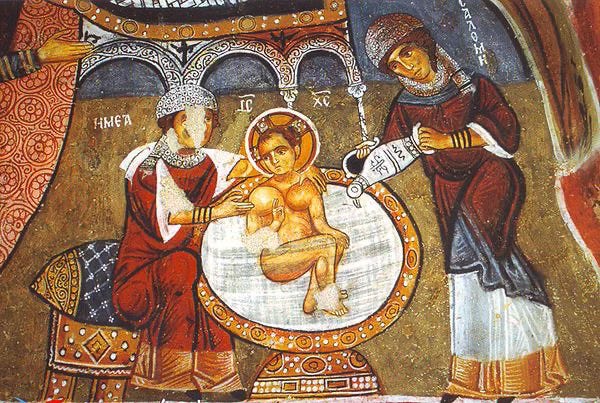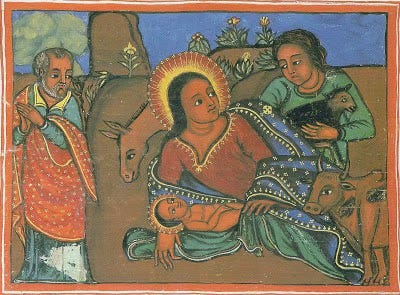Since Joseph belonged to David’s house and family line, he went up from the city of Nazareth in Galilee to David’s city, called Bethlehem, in Judea. He went to be enrolled together with Mary, who was promised to him in marriage and who was pregnant. While they were there, the time came for Mary to have her baby. (Luke 2: 4-6 CEB)
It concerns me that we have increasingly isolated the holy family from all the normal human interactions that surround a birth. First we relegate them to the stable away from the family with only Joseph to help. Then we don’t provide any midwife or other women to provide Mary with support and guide Jesus into the world. I can’t imagine a scene more uncomfortable for a young woman giving birth than to be surrounded only by men.
I don’t believe Mary was isolated and I am sure she had a midwife, even though she is not named in the scriptures so today I am posting an adapted version of my December 21st meditation in my book Celtic Advent: Following An Unfamiliar Path.
Just before Christmas I set up our Nativity set. Mary, Joseph, the shepherds, the Wise men and of course the animals. Where’s the midwife I ponder as I get ready to celebrate the twelve days of Christmas? Mary’s midwife is never present in the nativity sets we use to decorate our homes during Advent and Christmas season, though evidently she often appeared in Ancient Orthodox and Byzantine icons of the event.
While it’s true that Luke doesn’t mention the presence of a midwife in his account of the nativity, it’s impossible to imagine Mary giving birth without one, just as Jewish mothers had been for thousands of year. Like so many other figures in the gospel narrative, this midwife is never named, though Orthodox tradition calls her Salome and believe she also had an assistant with her. Other traditions suggest that Elizabeth was her midwife. Whoever she was, sometimes she is depicted in the corner or background of icons of the manger scene. She might be preparing something for Mary, observing quietly, or giving Jesus his first bath!

Irish tradition says that it was Brigid of Kildare who somehow travelled through time and space to be with Mary and deliver this precious child and provide for his early needs. It is hard for us to believe that Brigid was indeed transported back in time to perform this important role, but to the Irish, Brigid abides in eternity. They believed that her caring, compassionate heart was learned at the manger. She is seen as the companion of the Holy Family, Mary’s trusted friend and helper, a kind and faithful nurse to Jesus. This tradition continues today in Ireland, Scotland and Wales, reminding us that Jesus is always being born in our midst.
It’s probable that Mary and Joseph arrived in Bethlehem several days before Jesus was born. There is no sense of urgency in today’s scripture, no indication that Mary was already in labour when they arrived. It is probable that Mary and Joseph had ample time to prepare for her delivery and to seek out a local midwife. It is even likely that some of Joseph’s female relatives were there too. After all this was his home town and whether Jesus was born in a cave where animals were kept, or in a family home, as I suspect, in a culture as hospitable as this they would not have been left to birth the baby on their own.
This unnamed woman, reminds me of my early days as a physician in New Zealand when I too helped to bring babies into the world. It was the most precious experience imaginable, one that I never tired of. So I close my eyes and imagine myself transported back 2,000 years to give birth to that special child. After all if Brigid can travel through time I should be able to as well. I imagine myself comforting Mary as she cries out in the pangs of childbirth. I imagine listening for Jesus’s first breath, and hear him give his first cry. I bath him, gently wiping off the blood and fluids of his passage through the birth canal. Then I lay him on his mother’s breast, enthralled by her radiant smile and I beckon Joseph to her side.
It is hard to believe, as we think of this tiny child, so rudely and violently expelled into the world, and now lying quietly in all his vulnerability and dependency, that he is indeed the promised saviour, the son of God. Like I did after each delivery, did the midwife look at his tiny body in awe and wonder, filled with the joy and delight of helping to bring to birth a child in whom the divine spark was obviously present? Did she go away changed just as the shepherds and the wise men were changed by their encounter? Did she cherish the face of this child in her mind for the rest of her life aware that he was special and would transform the world?

Reflection
We have not all had children, or experienced the joy of delivering babies like I have, but most of us know people who have. Speak to a doula, midwife, doctor or nurse who has helped in the delivery of a baby. Or speak to your parents about your own birth or the birth of one of your siblings. What was that experience like for them? What emotions did it stir? How has it changed their view of God and of the world? Take time to reflect on what you learn. Close your eyes and imagine yourself in their position, holding a newborn baby in your arms. How do you think it would change you?
A newborn babe
brings light to the house
warmth to the hearth
and joy to the soul.
For wealth is family
family is wealth.
May strong arms hold you
Caring hearts tend you
And may love await you at every step.
May you bring light to the home,
warmth to the heart
Joy to the soul
And love to the lives you touch.





